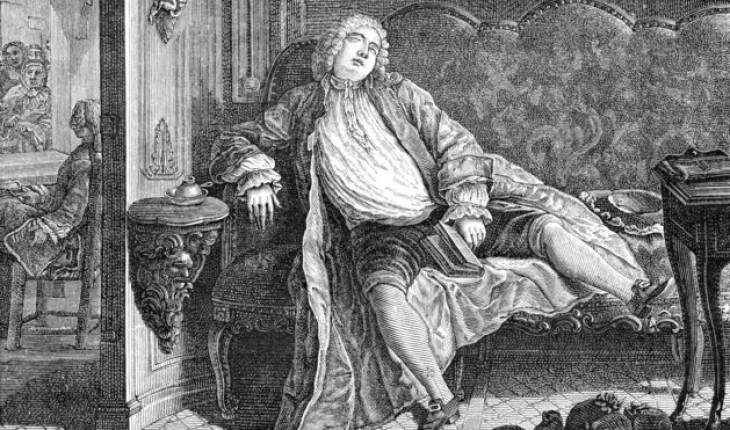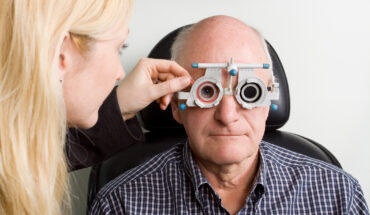In the 18th century, people may have slept in two separate nightly intervals, rather than one eight-hour period, historians say. (Print Collector via Getty Images)
Your ancestors probably woke up in the middle of the night. So why does it seem like a big deal when it happens today?
It’s undeniable that we need proper sleep not only to maintain our physical and mental health but also to function in our everyday lives. We consider eight uninterrupted hours of rest the marker of a healthy lifestyle — but is that really all that constitutes “proper sleep”?
Some scientists and historians have argued that we may not be built to sleep through the night in one long stretch. According to the work of one influential historian, our ancestors experienced sleep in a very different way.
Roger Ekirch, a historian at Virginia Tech University and author of At Day’s Close: Night In Times Past, has found that before the Industrial Revolution, humans likely slept in two separate intervals each night, waking for a while in between.
Ekirch laid out this thesis in 2001, when he published a paper based on 16 years’ worth of research suggesting that people slept in two distinct chunks. Being awake for an in-between period during the night was “a part of life’s rhythms,” according to Ekirch.
He first began investigating this phenomenon when he noticed the use of the terms “first sleep” and “second sleep” in a number of historical documents, including diaries, medical records and court documents. These accounts led him to believe that what he termed “segmented sleep,” or biphasic sleep, was at one time a common part of everyday life.
“I began to keep coming across references to first sleep and second sleep,” Ekirch told The Huffington Post. “One thing I found surprising was that the references were very casual — they were said in such a way as to assume that everyone else knew what they were referring to. That told me that this was not something unique or an anomaly.”
First Sleep, Second Sleep
Here’s what a night of biphasic sleep looks like: Not long after dark, typically around 9 p.m. or 10 p.m., people would go to bed. They would wake up again around midnight, stay up for roughly an hour, and then fall asleep again until around dawn.
The waking period was sometimes used for chores and mundane tasks, but was more often spent in meditation, introspection, sex and prayer (not necessarily in that order!), Ekirch said.
“People remained conscious, either in their beds or out, for up to an hour or so in which they did anything and everything imaginable, from performing chores such as brewing ale … to stealing a neighbor’s firewood,” he said. “Others never left their beds. They regarded this as a valuable, and in fact sacred, interval of time in which to reflect on the day’s events, meditate and pray.”
Doctors even told their patients to take medications during this period, which was also thought to be an ideal time for conception.
However, industrialization changed people’s sleep patterns. Once they were able to prolong the day’s activities with electric lighting, families stayed up later. After the clock was invented and more people began working in factories rather than on farms, people lived by strict time schedules rather than natural light patterns. Efficiency became an organizing principle of their lives — and their sleep.
Are We Meant To Sleep In Two Segments?
In a letter to the editor in the current issue of the journal Sleep, Ekirch questioned the findings of a much-publicized study from October that found evidence that individuals in three pre-industrial societies slept roughly 6.5 hours per night in a single interval. The authors of that study concluded that segmented sleep may have been unique to pre-industrial Europe because of the long winter nights there.
Segmented sleep is more widespread than this research suggests, Ekirch argued, and his work has shown evidence of this sleep pattern not only in Europe but also in regions including Latin America, the Middle East and Australia. Biphasic sleep may not be characteristic of all cultures, but it certainly seems to be present in a large percentage of pre-industrial cultures.
There’s also scientific evidence to support the idea that biphasic sleep may be a natural pattern. An experiment conducted in the 1990s showed that when left to their own (tech-free) schedules, people seemed to prefer sleeping in two chunks. After spending 14 hours in darkness each day for a month — as people did in the pre-electricity days — study volunteers naturally began to sleep in two shifts of roughly four hours each, waking up in between for a one- to two-hour period of activity.
Today, in the post-industrial technological era, there are even more environmental distractions vying for our resting time and tricking our brain into thinking it’s still daytime. Electric lights and blue light from screens confuse our mind into thinking it’s daytime when we should be getting ready to hit the hay.
A Historical Explanation For Insomnia?
Ekirch’s work has been widely embraced by sleep scientists and has informed our scientific understanding of insomnia.
An important implication of these historical findings is the idea that insomnia of the waking-up-in-the-wee-hours variety — as opposed to insomnia that involves struggling to fall asleep — is likely a remnant of this long-dominant pattern of sleep, rather than a disorder.
People with this type of insomnia, who likely have more sensitive circadian rhythms and a greater sensitivity to light, may be better suited to biphasic rather than consolidated sleep.
“Middle-of-the-night insomnia — the most common form of insomnia today — only becomes viewed as a medical problem in the late 19th and early 20th century,” Ekirch said. “Before then, awakening in the middle of the night was thought to be utterly natural.”
How can we use this knowledge to get better sleep within the confines of our modern, post-industrial lives? Turning back the clock and returning to pre-industrial sleep patterns probably isn’t the answer. However, regulating light exposure is a critical step, Ekirch said.
For instance, keep devices out of the bedroom, turn off the TV at least an hour before bedtime, and install blue light-minimizing apps like f.lux and the new Night Shift iOS feature for the iPhone.
If you’re struggling with insomnia, it can also help to understand and acknowledge that your sleep patterns aren’t abnormal. Instead of tossing and turning or scrolling through a Facebook feed, Ekirch recommends that insomniacs get out of bed and engage in a relaxing activity like reading under low lighting until they feel ready to return to bed.
“I hope … that people with insomnia will see that their sleep is not abnormal, at least from a historical perspective,” Ekirch said. “That knowledge should be of some comfort.”
Original Article: Huff Post




